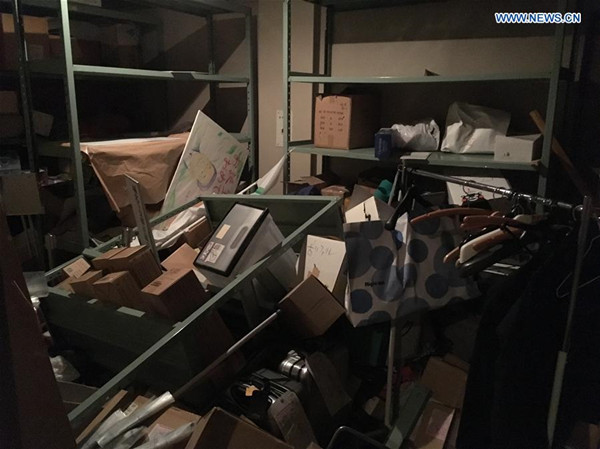
The photo taken on April 16, 2016 shows fallen shelves at a hotel after an earthquake in Kumamoto, southwestern Japan. Kumamoto Prefecture in southwestern Japan was hit again by a magnitude-7.1 earthquake on Saturday at 1:25 local time. (Xinhua/Liu Tian)
Japan's Kumamoto earthquake, which took place early on Saturday, was upgraded from a provisional magnitude of 7.2 to 7.3.
The temblor was felt across wide swathes of southern Japan and triggered a tsunami warning, although the advisory was later lifted.
As the situation in Kumamoto continues to escalate, a second quake registering magnitude-5.8 also struck in the region at 03:55 local time.
Prior to that, numerous aftershocks jolted the region that had already been pummeled by a series of quakes and aftershocks striking a day earlier.
Japanese Prime Minister Shinzo Abe's planned trip to the already quake-ravaged region, scheduled for Saturday, has been officially cancelled following the latest quakes and the likelihood of further aftershocks, according to his office.
Japan's top government spokesperson Chief Cabinet Secretary Yoshihide Suga told a press briefing that significant damage was feared to have been caused in the quake-hit region, with prefectural officials saying a municipal hall building has partially collapsed in the city of Uto in the embattled prefecture.
Local media reported the possibility of at least one death as a result of the latest quakes, with reports also being made of people being trapped beneath collapsed buildings and rubble, some have been reported to have been buried alive, as search and rescue operations swing into high gear just before sunrise.
Other media reports said some 190,400 households have been without power in the quake-ravaged prefecture.
One of the many aftershocks centered in neighboring Oita Prefecture resulted in numerous injuries being reported, local media said, as houses were seen to have collapsed in the town of Yufu, well-known for its natural hot springs and accompanying resort-type facilities.
Japan's Meteorological Agency (JMA) rattled the nation's nerves by initially issuing a tsunami warning just two minutes after the main quake struck in the early hours of Saturday, saying waves of up to one meter could hit the coast of Japan, with the advisory given for both the Ariake and Yatsushiro sea areas.
The warning was later cancelled.
Regarding the possibility of further quakes and aftershocks, the weather agency has advised enhanced vigilance from the public, particularly in hilly areas where mudslides are highly possible.
Xinhua reporters in Mashiki have been spending the night on the opening ground, feeling aftershocks hitting regularly and there was widespread panic in the town with people seen flee from buildings to open areas, with some ducking into vehicles for protection.
The town being plunged into darkness following a power cut is adding to the alarm.
The number of further fatalities and injuries, as yet, has been unreported by prefectural officials and rescue services in the quake-hit region, although rising numbers of injuries are widely expected.
Prefectural officials once again on Saturday confirmed that no abnormalities had been noticed at any of the nuclear facilities in the quake-affected areas.
Kyushu Electric Power Company said following Friday's quake its Number 1 and Number 2 reactors at its Sendai nuclear power plant in Satsuma-Sendai City, in the quake-hit prefecture, were functioning normally. The two are the only reactors currently online in Japan.
The majority of Japan's nuclear power plants remain offline for regular safety inspections and in the wake of the massive earthquake-triggered tsunami in March 2011, that pummeled the Daiichi nuclear facility in Fukushima Prefecture, in Japan's northeast, leading to the worst commercial nuclear crisis in history.
Following Saturday's quake, large sections along major arterial routes and expressways have been closed off, the traffic information center confirmed.


















































